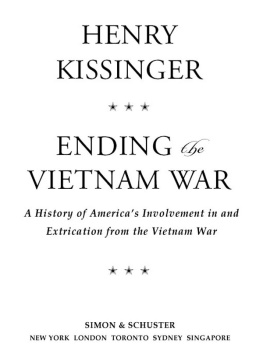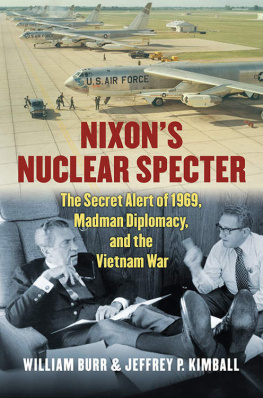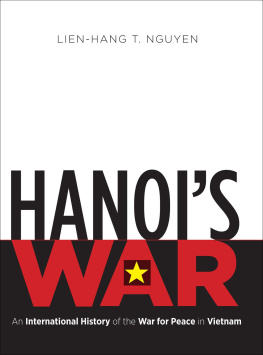
* * * *
White House Years
[White House YearsVolume One]
Henry Kissinger
Scanned & Proofed By MadMaxAU
* * * *
Contents
I.
NelsonRockefeller The Phone Call Meeting Richard Nixon Encounters at the Pierre Hotel
II.
GettingAcquainted The Uneasy Team Getting Organized Turning toSubstance
III.
AnHistorians Perspective The American Experience Problemsof a New Equilibrium
IV.
NixonVisits Europe Malaise of the Western Alliance London and the SpecialRelationship Bonn and Berlin and the Enigma of Germany Rome Interlude The Colossus of de Gaulle
V.
Introductionto Anatoly Dobrynin The Enduring Philosophical Problem of US-SovietRelations Reflections during the Transition Period Public andCongressional Attitudes: A Spring Flurry The Channel Preparingfor SALT East-West Trade Eastern Europe: Nixons Visit toRomania Conclusion
VI.
FirstSignals The Ussuri River Clashes Rumors of War Triangular Politics
VII.
Defenseand the Strategic Balance The Defense Debate AntiballisticMissiles (ABM) Multiple Independently Targetable Reentry Vehicles(MIRV) The Attack on the Defense Budget Strategic Doctrine Tactical Nuclear Weapons One and a Half Wars The NixonDoctrine
VIII.
MyExposure to the Quagmire What We Found North Vietnamese Attacksand Cambodian Bombing Diplomacy for a Peace Settlement TheVance Mission Return to the Treadmill The Beginning of TroopWithdrawals A Secret Meeting with Xuan Thuy AnotherReassessment The Unpacifiable Doves Groping for a Strategy
IX.
TheEC-121 Shootdown The US-Japanese Alliance The OkinawaNegotiation The Textile A Fiasco
X.
InitiativesGalore Middle East Visitors Diplomacy: Ever-New Proposals Yet Another Initiative Golda Meir The Rogers Plan The Evolving Strategy
XI.
Dilemmasof Europes Success Consultations De GaullesDeparture and European Unity The Common Defense: The AmericanPerception East- West Relations in Europe Berlin and Brandts Ostpolitik European Security Conference European Leaders Visit Washington: 1970 Second Thoughts about the Common Market
XII.
Returnto Secret Negotiations Special Adviser Le Duc Tho and the First Roundof Talks Laos Interlude The Overthrow of Sihanouk The April20 Troop Withdrawal Announcement The Attack on North VietnameseSanctuaries The Elusive Communist Headquarters and Other Battles The Domestic Travail The Balance Sheet,
XIII.
Hotand Cold The Riddle of Soviet Conduct Ostpolitik SALTand the Defense Debate Pursuing a Moscow Summit
XIV.
TheKosygin Letter Soviet Soldiers and Missiles Appear in Egypt AnAmerican Diplomatic Initiative Cease-fire and Standstill IsraelBows out of Negotiations
XV.
Crisisin Jordan Iraqi-Jordanian Showdown Hijacking Crisis Showdown with the Guerrillas The Syrian Invasion
XVI.
AMessage from Moscow A Flotilla Heads for Cienfuegos TheShowdown Resolution of the Crisis
XVII.
SalvadorAllende Influence and Intervention: The 40 Committee TheChilean Election of 1970 The Coup That Never Was AllendeInaugurated
XVIII.
TheEnd of the Warsaw Channel Triangular Relationships ThePakistani Channel Ping-Pong Diplomacy Plans and Aberrations
XIX.
PoloI: Prelude The Middle Kingdom: First Meeting with Chou En-lai The Announcement That Shook the World The China Card China at the United Nations Polo II The UnitedNations
XX.
ThePolish Riots The Channel Becomes Operational The SALTNegotiations and the May 20 Agreement The Berlin Negotiation The Summit Finally
XXI.
Originsof Tragedy Two Cyclones Military Crackdown The CrisisAccelerates The Soviet-Indian Friendship Treaty Contactswith the Bangladesh Exiles Mrs. Gandhi Comes to Washington Warbetween India and Pakistan The War Spreads Climax: A FatefulDecision The Aftermath
XXII.
MediterraneanJourney De Gaulles Funeral and Heaths Visit TheMansfield Amendment: The Old Guard Steps into the Breach The EconomicCrisis: The Second Nixon Shock High-Level Consultations:The Final Round
XXIII.
MadameBinhs Eight Points The Setting of a Strategy The LaosOperation Lam Son 719: The Military Operation The Marches onWashington The Negotiations Are Resumed The South VietnamesePresidential Election Revealing the Secret Talks
XXIV.
TheHaig Mission Arrival: The Handshake Mao Tse-tung Walks,Talks, and Toasts The Shanghai Communiqu Assessments
XXV.
Invasion The Buildup Diplomatic Maneuvers What Strategy?
XXVI.
Preparingthe Summit Leonid Brezhnev Conversations with Brezhnev andGromyko A Disagreement with the President
XXVII.
Preparingfor Decision The May 2 Secret Meeting The Mining of NorthVietnam The Summit in the Balance Postlude
XXVIII.
RichardNixon in the Kremlin Greetings and Meetings The Soviet PowerStructure: Kosygin and Podgorny Round One on SALT: Brezhnev and Nixon Confrontation at the Dacha The SALT Negotiations Conclude Gromyko and the Middle East What Did the Summit Accomplish?
XXIX.
AVisit to the Shah of Iran Return through Warsaw The SovietGrain Deal European Attitudes
XXX.
TheDeath of Nasser The Idea of an Interim Settlement The PhantomMemorandum Becoming Involved Backchannel Explorations Egypt Opens a Secret Channel to the United States
XXXI.
HanoisDiscomfiture Testing the Stalemate A Visit to Saigon Interlude: Meetings of September 15 and 27 The Breakthrough: TheOctober 8 Meeting
XXXII.
Interludein Paris, 1364 Consultation with Thieu, First Rumblings Showdown with Thieu The Journey Home
XXXIII.
HanoiGoes Public Election Interlude Haig Visits Saigon Again The Meetings with Le Duc Tho Resume The December Talks: Breakdown ofthe Negotiation The Christmas Bombing Negotiations Resume The January Round Thieu Relents
XXXIV.
Postlude
* * * *
Listof Maps
(Maps by DickSanderson)
Sino-Soviet BorderClashes 1969
Cambodia: NorthVietnamese Base Areas and Menu Strikes 1969
Korea and Area ofEC-121 Shootdown 1969
Laos 1970
Cambodia: NorthVietnamese Attacks April 3-24, 1970
Jordan 1970
South Asia 1971
India-Pakistan War1971
(Adaptedfrom Strategic Survey1971, courtesy of the International Institute for StrategicStudies)
South Vietnam:Military Regions
Laos Operation 1971
North Vietnam:Route Packages 1972
* * * *
Foreword
or better or worse I was called upon toplay a prominent role in the making and execution of United States foreignpolicy, first as President Nixons Assistant for National Security Affairsand later as Secretary of State under President Nixon and President Ford. Thisbook is an account of our foreign policy during the first term of Richard NixonsPresidencyfrom my appointment as national security adviser after theNovember 1968 election through the end of the Vietnam negotiations, roughlycoincident with Nixons second inauguration in January 1973.Inevitably, it is history seen through my eyesa portrayal of what I sawand thought and didand inevitably I have had to select and compress. Acomplete record in the historians sense must await the publication ofother documents, memoirs, and biographiesnot all of American origin.
The period coveredin this volume was marked by domestic division and international turmoil; itwitnessed Americas passage into a world in which we were no longerpredominant though still vastly influential. It was a painful transition, not,I hope, without achievement, that began the process of a new and in the longrun perhaps even more seminal American contribution to the prospects of freesocieties. For some, the treatment in this volume of controversial matters,especially the Vietnam war, will be the view from a side of the barricadesunfamiliar to them. It is put forward here as honestly as possible, with theintention to reconcile, not to score retrospective debating points. As a nationwe can transcend our divisions only by recognizing that serious people mannedboth sides of those barricades.
Next page
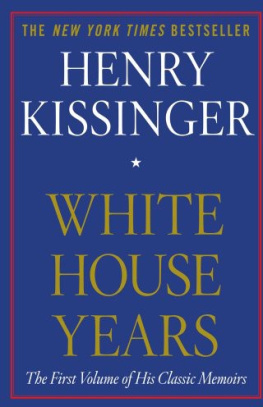


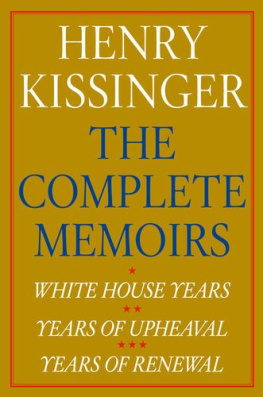
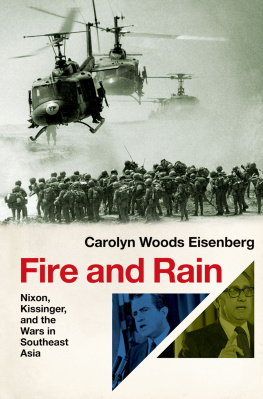
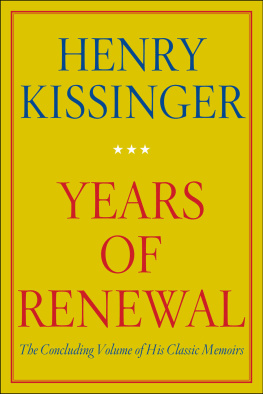
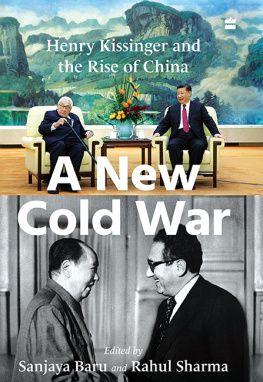
![Kissinger - Years of Upheaval: [VOL2 Classic Memoirs]](/uploads/posts/book/181244/thumbs/kissinger-years-of-upheaval-vol2-classic.jpg)
